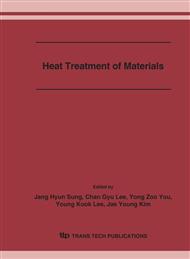p.317
p.323
p.331
p.337
p.343
p.349
p.355
p.363
p.369
A Finite Element Model for Heat Treatment of Steel Alloy
Abstract:
A finite element model was developed to simulate the deformation, temperature and phase transformation behavior in high carbon steels. The heat capacity of each phase and the heat evolution due to phase transformation were obtained from the thermodynamic analysis of S45C, 50CrV4 and SK85 steels. Phase transformation kinetics of the steels were derived from continuous cooling experiments. An additivity technique was applied to a modified Johnson-Mehl-Avrami equation to analyze continuous cooling curve. To predict the strain due to TRansformation Induced Plasticity (TRIP), a variant selection model for diffusionless transformation and an accelerative creep model for diffusional transformation were adopted. In order to calculate the deformation behavior, the elastic strain, the volumetric strain due to thermal contraction and phase transformation, the plastic strain and the TRIP strain were taken into account. Using the finite element model developed in this study, the temperature-phase-deformation behavior of the high carbon steels was calculated.
Info:
Periodical:
Pages:
343-348
Citation:
Online since:
December 2006
Authors:
Price:
Сopyright:
© 2006 Trans Tech Publications Ltd. All Rights Reserved
Share:
Citation:


